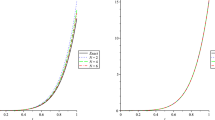Abstract
In this work numerical methods for integration with respect to binomial measures are considered. Binomial measures are examples of fractal measures and arise when multifractal properties are investigated. Interpolatory quadrature rules are considered. An automatic integrator with local quadrature rules that generalize the five points Newton Cotes formula and error estimates based on null rules is then described. Numerical tests are performed to verify the efficiency and accuracy of the method. These tests confirm that the automatic integrator turns out to be as good as one of the best known quadrature algorithms with respect to the Lebesgue measure.
Similar content being viewed by others
References
P. Abry, R. Baraniuk, P. Flandrin, R. Riedi, and D. Veitch, The multiscale nature of network traffic: Discovery, analysis, and modelling, IEEE Signal Process. Magazine, 19(3) (2002), pp. 28–46.
L. Ambrosio, N. Fusco, and D. Pallara, Functions of Bounded Variation and Free Discontinuity Problems, The Clarendon Press/Oxford University Press, New York, 2000, (Oxford Mathematical Monographs).
A. Barinka, T. Barsch, S. Dahlke, M. Mommer, and M. Konik, Quadrature formulas for refinable functions and wavelets. II. Error analysis, J. Comput. Anal. Appl., 4(4) (2002), pp. 339–361.
M. F. Barnsley, Fractals Everywhere, 2nd edn., Academic Press Professional, Boston, MA, 1993, (Revised with the assistance of and with a foreword by H. Rising, III).
M. F. Barnsley and S. Demko, Iterated function systems and the global construction of fractals, Proc. R. Soc. Lond., Ser. A, 399(1817) (1985), pp. 243–275.
J. Berntsen and T. O. Espelid, Error estimation in automatic quadrature routines, ACM Trans. Math. Softw., 17(2) (1991), pp. 233–253.
F. Calabrò and A. Corbo Esposito, Binomial measures and quadrature formulae, submitted, preprint avaible on arXiv.org: math.NA/0612190, 2008.
L. Carbone, G. Cardone, and A. Corbo Esposito, Binary digits expansion of numbers: Hausdorff dimensions of intersections of level sets of avarages’ upper and lower limits, Sci. Math. Jpn., 60(2) (2004), pp. 347–356.
G. Cardone, A. Corbo Esposito, and L. Faella, Hausdorff dimension for level sets of upper and lower limits of generalized averages of binary digits, Math. Methods Appl. Sci., 29(16) (2006), pp. 1983–2008.
T. O. Espelid, Doubly Adaptive Quadrature Routines Based on Newton–Cotes Rules, Reports in Informatics, vol. 229, Dept. of Informatics, Univ. of Bergen, Norway, 2002, pp. 1–34.
T. O. Espelid, Doubly adaptive quadrature routines based on Newton–Cotes rules, BIT, 43 (2003), pp. 319–337.
T. O. Espelid, Algorithm 868: Globally doubly adaptive quadrature – Reliable Matlab codes, ACM Trans. Math. Softw., 33(3) (2007), pp. E1–E21.
W. Gander and W. Gautschi, Adaptive quadrature – revisited, BIT, 40(1) (2000), pp. 84–101.
W. Gautschi, A survey of Gauss–Christoffel quadrature formulae, in E.B. Christoffel, P. L. Butzer and F. Fehér, eds., Birkhäuser, Basel, 1981, pp. 72–147.
W. Gautschi, Orthogonal polynomials and quadrature, Electron. Trans. Numer. Anal., 9 (1999), pp. 65–76.
W. Gautschi, L. Gori, and F. Pitolli, Gauss quadrature for refinable weight functions, Appl. Comput. Harmon. Anal., 8(3) (2000), pp. 249–257.
J. E. Hutchinson, Fractals and self-similarity, Indiana Univ. Math. J., 30(5) (1981), pp. 713–747.
D. Huybrechs and S. Vandewalle, Composite quadrature formulae for the approximation of wavelet coefficients of piecewise smooth and singular functions, J. Comput. Appl. Math., 180(1) (2005), pp. 119–135.
D. P. Laurie and J. M. de Villiers, Orthogonal polynomials for refinable linear functionals, Math. Comput., 75(256) (2006), pp. 1891–1903 (electronic).
H. Liangxiu, C. Zhiwei, C. Chunbo, and G. Chuanshan, A new multifractal network traffic model, Chaos Solitons Fractals, 12 (2002), pp. 1507–1513.
G. Mantica, A stable Stieltjes technique for computing orthogonal polynomials and Jacobi matrices associated with a class of singular measures, Constructive Approximation, 12(4) (1996), pp. 509–530.
G. Mantica, Fractal measures and polynomial sampling: IFS-Gaussian integration, Numer. Algorithms, 45(1–4) (2007), pp. 269–281.
G. Mantica and D. Guzzetti, The asymptotic behaviour of the Fourier transforms of orthogonal polynomials. II. L.I.F.S. measures and quantum mechanics, Ann. Henri Poincaré, 8(2) (2007), pp. 301–336.
L. Olsen, Multifractal geometry, Prog. Probab., 46 (2000), pp. 3–37.
H.-O. Peitgen, H. Jürgens, and D. Saupe, Chaos and Fractals: New Frontiers of Science, Springer, New York, 1992 (With a foreword by M. J. Feigenbaum, Appendix A by Y. Fisher, Appendix B by C. J. G. Evertsz and B. B. Mandelbrot).
Y. Pesin and H. Weiss, The multifractal analysis of Gibbs measures: Motivation, mathematical foundation, and examples, Chaos, 7(1) (1997), pp. 89–106.
Y. Pesin and H. Weiss, The maltifractal analysis of Birkhoff averages and large deviations, in Global Analysis of Dynamical Systems, IoP Publishing, Bristol, 2001.
A. Quarteroni, R. Sacco, and F. Saleri, Numerical Mathematics, 2nd edn., Texts Appl. Math., vol. 37, Springer, Berlin, 2007.
R. H. Riedi, Multifractal processes, in Theory and Applications of Longrange Dependence, Birkhäuser, Boston, MA, 2003, pp. 625–716.
W. Rudin, Real and Complex Analysis, 2nd edn., McGraw-Hill, New York, 1974 (McGraw-Hill Series in Higher Mathematics).
A. Venter and D. P. Laurie, A selection criterion in a doubly adaptive integration algorithm, BIT, 42(1) (2002), pp. 183–193.
Author information
Authors and Affiliations
Corresponding author
Additional information
AMS subject classification (2000)
28A25, 60G18, 65D30, 65D32, 68M15
Rights and permissions
About this article
Cite this article
Calabrò, F., Corbo Esposito, A. An efficient and reliable quadrature algorithm for integration with respect to binomial measures . Bit Numer Math 48, 473–491 (2008). https://doi.org/10.1007/s10543-008-0168-x
Received:
Accepted:
Published:
Issue Date:
DOI: https://doi.org/10.1007/s10543-008-0168-x



